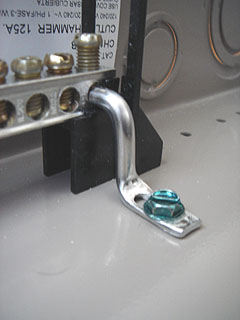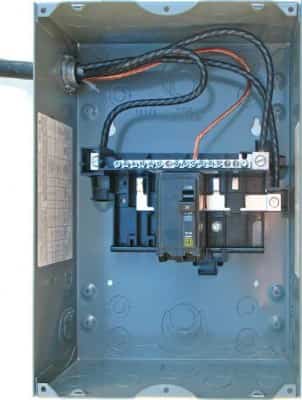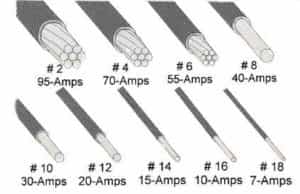In this how-to install a sub-panel installation I will guide you through the complete installation of a subpanel step by step.
The first question is why are you installing a subpanel. There are either one or two reasons to do this. One because you need more room in your existing panel and in that case if your existing panel is old this would be a great time to just upgrade your current service. Newer 200 amp main panels hold a lot more circuits/breakers.
Two, because you need to bring more power somewhere else like a garage you just built or addition or even in some cases a finished basement. Either way, you want to install a subpanel. Ok. So let’s get going.
First: Where do you plan on placing the new sub-panel? If it’s right next to your main panel that’s one thing, but further away like in that new garage you just built 100 feet away you will certainly want to figure in voltage drop. I can’t get too much into that because every setup would be different.
Second: How many amps are you needing for the new sub-panel. So let’s say you need 50 amps. Well, it’s not brain surgery, 50 amp sub panel, 50 amp wire, 50 amp breaker in the existing main panel. See wasn’t that easy.

Neutral Bonding Jumper:
This is very very important. This is also known as a bonding screw. It may even be green. This screw is used to bond the neutral coming in the main panel to the case “panel” itself. however, in a sub panel, the neutral bus bar must be totally isolated from the ground. The very first thing the electrical inspector is going to look for is if the sub-panel is bonded or not.
Now as far as wiring the panel. You would wire it just like any other panel. Hot leads to the breakers, grounds to the ground bus bar, and neutrals to the neutral bus bar.
But Why Do You Need To Remove The Green Screw?
Because the neutral only gets bonded at 1st means of disconnect so any unbalanced load only has one true path to the ground and that’s at the power source.
You would install a 220-volt two-pole breaker in the main existing panel. Whatever the amperage is that you’re using. That breaker gets installed in the main panel of course. This is now the main breaker to your sub-panel. By turning this breaker on or off will control the entire subpanel.
Always remember safety first. Turn the main power off before removing panel covers or touching any wires.
You will need a 4 wire, wire between each panel. No matter how the panel is, this part will always stay the same. You will have two hots, one neutral and one ground. Two hots will go from the new breaker you just installed in the main panel to the sub-panel. A neutral will go from the neutral bus bar in the main panel to the NON bonded bus bar in the sub-panel and ground from the ground bus bar in the main panel to the bus bar in the new sub-panel.



Comments ( 74 )
New construction, 200 amp homline. I’m feeding a 100 amp sub panel. Right wire, no bond screw in the sub panel, separate ground bus bonded and grounded with new ground rod. In coming ground from 200 amp is connected to this bonded ground bus bar. No loads on sub panel. When I turn on the 100 amp double pull breaker to energize, it trips immediately.
Bond screw is in 200 amp panel and working great. With the bond screw in, is there a difference in what bus bar I use for ground and neutral?
What about the neutral in the sub-panel?
Hi, yes it is a mobile home. My main service is 200amp. The panel I am trying to add is 100 amp. The only reason I am trying to add the 100 amp sub panel is because they crammed so many wires into shared breakers (including some 220v 20a/40a breakers) and there is absolutely no room to even add one more 220v breaker if needed.
We have about 4 110v 15a feeds coming into the top of the current panel. The main feed and other feeds are coming into that panel from the bottom. I figured that if I add the sub panel above the old panel I can move the 4 110v 15a breakers to the new sub panel above. I have just never seen a sub panel mounted directly above a main panel and not sure if you think anything sounds wrong about doing this.
Dominick Amorosso January 10, 2016
Hi, I assume you’re talking about a mobile home!. In that case, the first question would do you have enough on the main service for what you’re trying to do?
Tom January 9, 2016
Hi Dominick,
Firstly, Thank you for your contribution to this world.
Do you see any problem with installing an in wall sub panel above a currently installed in wall panel inside a manufactured home? The currently installed indoor panel feeds off of an outdoor main panel if that matters.
I do understand that if I installed a panel above the existing indoor panel that I would have to move the wires coming into the current panel from the top to the new panel i install above it. I just haven’t seen it done anywhere else and wanted to know if you see any possible issues with this.
Well if you watch my video you’ll see that the sub-panel is right next to the main panel. A sub for more breakers, or remote to another location. All the same. As far as what you’re doing size wise I can’t say because I’m not there of course.
In my comment below I should have said feeds leaving the top of the current panel sorry.
The sub panel is not bonded. I removed the screw and only has main lugs. Neutral bus bars run up and down both sides. I added a ground bus bar that is attached to the ground/neutral bus bar on the main panel and also to a ground rod. Can’t quite make sense of it. I do have some Commons and ground wires from some 20 and 15 amp circuits both attached to the bonded neutral bars on the 200 amp main panel. Does it matter even though it’s bonded to the ground?
go to the ask questions of this site and post some pictures for me.
Dominick,
Excellent video. Very well explained.
I currently have a sub panel in a small barn about 600ft away from the main home/main service panel. Would like to add electric service to another shed which is also about 600 ft away from the main service and about 100 feet from the existing barn/subpanel.
The wire to the sub panel (all installed by an electrician) is underground. It comes up next to the existing barn in a PVC pipe which goes through the barn wall and then to the sub panel. They used an extra thick gauge wire to minimize power loss over the long run.
Is it possible to tap into this and feed another sub panel for a shed? If so, what is the best way?
My thought is to split the line where is comes up to the existing barn using an outdoor junction box. One line would run to the existing barn and a second line would be run to the new shed 100 feet away. (A new trench would be dug for the new wire). I am not sure if this type of splice if permissible.
The other, less preferable solution would be to run a sub panel in the new shed off the existing barn sub panel…. sub panel to sub panel. Again, I’m not sure if this is permissible.
If a new run from the house is needed, the project would be costs prohibitive. I think I could tackle this myself, but may consider an electrician for all/some of the work. Either way, I want to know the “right” way to do it so I make sure an electrician is not taking and shortcuts.
Thanks in advance for any advice you can provide.
This is mainly going to depend on the amp requirements to the shed. However, I would just install a breaker on the barn sup-panel for the new run to the shed.
Thanks for the info. For some reason I had it in my head that I could not run a branch circuit to the separate shed. Seems that is allowed… will take your advice and plan to run a 20a line to a disconnect in the shed. It is only needed for a few lights, so 20a is more than enough. Thanks.
Sure thing. Almost forgot. Do make sure you install a grounding rod at the shed.
RE: Grounding rod…
If I install a grounding rod at the shed, would I still run three wires from the sub panel? I am under the impression that I run a ground wired from the panel to the shed, I would not use a grounding rod. If I DO not run a ground wire, I should not use a grounding rod.
Or is it proper to use both a ground wire and a grounding rod?
Thanks,
Yes always use both if it is a separate building.
Hi Dom, do I need to connect a ground wire from main panel, to the sub panel “Garage”?
I am putting in a ground rod for the sub panel.
Seems like if I do add the ground wire from the main panel, there will be no isolation of the Natural and Ground in the sub panel. Can you explain this for me.
Thanks for all your time, you are an inspiration to your trade.
Bill
Yes you should have the ground from panel to panel. But what kind of wire do you have installed?
Hi Dom, my current panel is 125 amps and seems under sized (3 bedrooms 2 bath/1600 sf house. Plus I need some more power outlets. My question is if I add a sub panel am I just taking from the existing 125 amp panel power?
Oh yes, adding a sub-panel will take right from the main breaker.
I installed a sub panel as per your instructions. Now I am installing a 220v 20 amp circuit breaker.
I used 220 3 wire for my saw do I take the ground wire and attach this to the ground bar or neutral bar beings how I do not have both? I was thinking I install it looking at this video to the ground bar.
Thanks
This is all going to depend on if you need a neutral for your saw. Chances are you do not us you could’ve just used a 12/2 wire. So if that’s so just use the two hots and the ground.